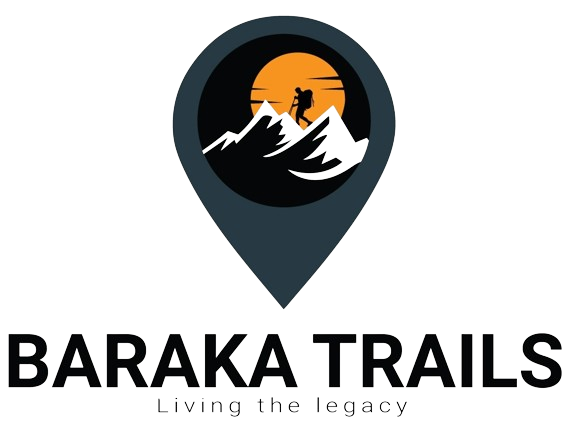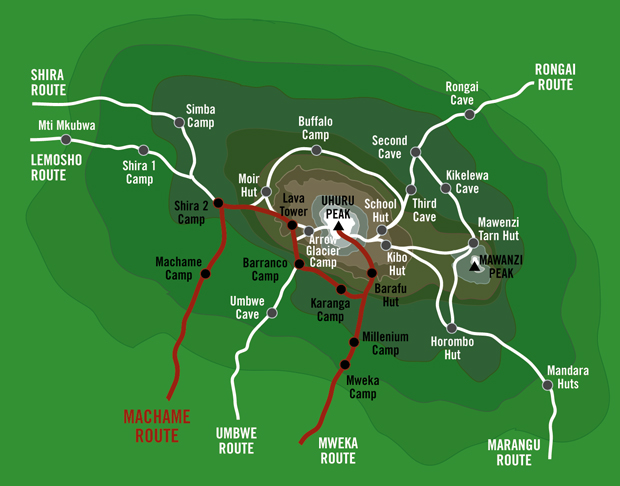6 Days Machame Route



The Machame Route is another well-known path for trekking up Mount Kilimanjaro. Renowned for its stunning landscapes and demanding terrain, it is often seen as more physically challenging than the Lemosho Route. Starting on the southern side of the mountain, the Machame Route typically takes 6-7 days to complete. Hikers will journey through diverse ecosystems, including rainforest, heath, and moorland, before reaching the summit. Similar to the Lemosho Route, the Machame Route boasts a success rate of approximately 70%.
Day 1: Machame Gate to Machame Camp
- Elevation: 1,800m to 2,835m (5,905ft to 9,301ft)
- Distance: 11km (7 miles)
- Hiking Time: 5-7 hours
- Habitat: Rainforest
The trek begins at Machame Gate after a short drive from Moshi. You’ll hike through the lush rainforest, rich with flora and fauna, until you reach Machame Camp.
Day 2: Machame Camp to Shira 2 Camp
- Elevation: 2,835m to 3,850m (9,301ft to 12,631ft)
- Distance: 5km (3 miles)
- Hiking Time: 4-6 hours
- Habitat: Moorland
The trail steepens as you leave the rainforest and enter the moorland zone. You’ll cross several streams and walk along a ridge before reaching Shira 2 Camp on the Shira Plateau.
Day 3: Shira 2 Camp to Barranco Camp via Lava Tower
- Elevation: 3,850m to 3,900m (12,631ft to 12,795ft)
- Distance: 10km (6 miles)
- Hiking Time: 6-8 hours
- Habitat: Semi-desert
You ascend to the Lava Tower at 4,630m (15,190ft) for acclimatization before descending to Barranco Camp. This “climb high, sleep low” strategy helps with acclimatization.
Day 4: Barranco Camp to Barafu Camp
- Elevation: 3,900m to 4,673m (12,795ft to 15,331ft)
- Distance: 9km (5.5 miles)
- Hiking Time: 8-10 hours
- Habitat: Alpine Desert
The day begins with a climb up the Barranco Wall, a non-technical but challenging section. The route then traverses several valleys and ridges before reaching Barafu Camp.
Day 5: Barafu Camp to Uhuru Peak to Mweka Camp
- Elevation: 4,673m to 5,895m (15,331ft to 19,341ft) (Uhuru Peak), then down to 3,068m (10,065ft)
- Distance: 5km ascent, 12km descent (3 miles ascent, 7 miles descent)
- Hiking Time: 10-15 hours
- Habitat: Arctic to Moorland
The summit attempt starts around midnight. You’ll trek through the Arctic zone to reach Uhuru Peak at sunrise. After celebrating at the summit, you descend back to Barafu Camp for a short rest and then continue down to Mweka Camp.
Day 6: Mweka Camp to Mweka Gate
- Elevation: 3,068m to 1,640m (10,065ft to 5,380ft)
- Distance: 10km (6 miles)
- Hiking Time: 3-4 hours
- Habitat: Rainforest
The final descent takes you through the rainforest to Mweka Gate. After checking out, you will be driven back to Moshi, marking the end of your Kilimanjaro adventure.
Summary
This 6-day Machame route itinerary provides a challenging yet rewarding trek with varied landscapes and effective acclimatization. Each day brings unique scenery and experiences, culminating in the ultimate goal of reaching Uhuru Peak, the highest point in Africa.
- Price Include:
* All transfers* Accommodation
* all trekking fees,
* All meals while on the Mountain
* Guides, Porters, cook salaries and park fees
* Quality Mess tents with table and chairs
* English speaking guide
* Sleeping bags
* Porters salary
• 3 meals in a day
• Mineral drinking water.
Price Exclude:* Tips,
* medical insurance cover
* all trekking personal gears
* alcohol
* all things of personal nature
What is Mount Kilimanjaro?
- Mount Kilimanjaro is the highest peak in Africa, located in Tanzania. It is a dormant volcano and one of the most iconic mountains in the world.
How tall is Mount Kilimanjaro?
- The summit of Mount Kilimanjaro, called Uhuru Peak, stands at an elevation of 5,895 meters (19,341 feet) above sea level.
How long does it take to climb Mount Kilimanjaro?
- The duration of a Kilimanjaro climb varies depending on the route chosen. Most climbs typically range from 5 to 9 days.
What are the different routes up Mount Kilimanjaro?
- There are several routes to the summit of Kilimanjaro, each with its own characteristics and scenery. Popular routes include the Marangu, Machame, Lemosho, Rongai, and Northern Circuit routes.
Is climbing Mount Kilimanjaro difficult?
- Climbing Kilimanjaro is challenging due to its high altitude, but it doesn’t require technical climbing skills. However, climbers should be physically fit and prepared for the rigors of high-altitude trekking.
Do I need a guide to climb Mount Kilimanjaro?
- Yes, it is mandatory to have a registered guide accompany you on your Kilimanjaro climb. Guides are essential for safety, navigation, and providing support throughout the trek.
When is the best time to climb Mount Kilimanjaro?
- The best times for climbing Kilimanjaro are during the dry seasons, which are typically from late June to October and from December to March. These months offer clearer skies and better trekking conditions.
What should I pack for climbing Mount Kilimanjaro?
- Essential items for climbing Kilimanjaro include proper clothing for varying temperatures, sturdy hiking boots, a good quality sleeping bag, trekking poles, personal medications, and other necessary gear as recommended by your tour operator.
What are the risks of climbing Mount Kilimanjaro?
- The main risks of climbing Kilimanjaro include altitude sickness, which can affect anyone regardless of fitness level, as well as other potential hazards such as extreme weather conditions and physical exhaustion.
Do I need to train before climbing Mount Kilimanjaro?
- Yes, it is highly recommended to undergo physical training and preparation before attempting to climb Kilimanjaro. This can include cardiovascular exercises, strength training, and hiking to build endurance and fitness levels.
Per Person $2,350
GROUP $2010

